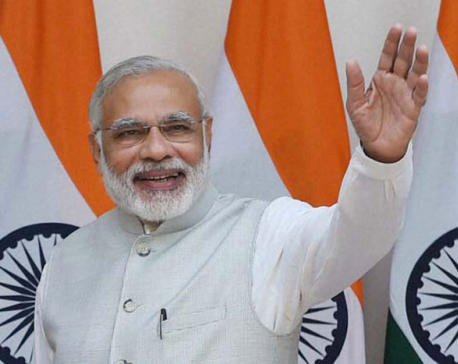
OR
Nepal, India expedite work to restore lost, damaged border pillars in five years
Published On: January 29, 2018 08:13 AM NPT By: Republica | @RepublicaNepal
KATHMANDU, Jan 29: With the aim of settling border disputes arising mainly out of the lack of clear demarcation, Nepal and India have expedited ‘field work’ to restore all lost or damaged border pillars along the Nepal-India border within the next five years.
The two countries have deployed four field survey teams (FSTs) along different border stretches with the mandate to construct, restore and repair border pillars; carry out GPS observation of border pillars; develop modalities to address cross-border occupation and encroachment of the no man’s land, according to the Department of Survey (DoS). Each FST jointly led by a chief district officer from Nepal and a district magistrate from India includes the district chief of the Armed Police Force (APF) and their Indian counterpart from Shashastra Seema Bal and technical officials from the Department of Survey.
Director General at DoS, Ganesh Prasad Bhatta said the four FSTs have already begun their work in different stretches of Nepal-India border. “We plan to conclude the work in the next five years,” he said.
Nepal and India share 1,880-kilometer long open border including a 640-kilometer long ravine border. As many rivers which have been recognized as the border between the two countries have changed their original courses at a number of places and the border pillars installed earlier have gone missing, Nepal and India have seen border disputes at different places.
The FSTs deployed as per the decision of a meeting of the Survey Officials’ Committee (SOC) of the two countries held in the Indian city of Deharadun in December, 2014 had originally planned to conclude the task in three years. But as the FSTs could install only 600 of the total 2,583 new pillars to be installed in three years, the countries later decided to extend the term for another five years.
The two sides have identified 8,583 locations for the installation of border pillars. Of these locations, border pillars have either been repaired or new pillars installed at 6,603 locations so far. “Now, we have to erect over 2,000 border pillars. We have set the target of completing this task within the next five years,” said Director General Bhatta.
DoS officials said four separate joint FSTs have started their work this year. In the first stage, FSTs inspect the border in order to identify the damaged and missing border pillars, their locations and prepare an inventory. In the second phase, they carry out the actual repair and installation of the border pillars. Likewise, the joint FSTs prepare an inventory of the encroachment upon the no-man’s land in the third phase. The encroached land, if any, is cleared with the help of local authorities, keeping 9.2 meter space open on either side of the no-man’s land.
In the fourth phase, the FSTs prepare the GPS coordinates of all border pillars so that there will be no further disputes even if the boundary maps get destroyed.
Officials said one FST is carrying out these tasks at the Indo-Nepal border from Sunsari to Taplejung district in eastern Nepal, adjoining Bihar and West Bengal states of India. The remaining three FSTs have been mobilized from Saptari district to Chitwan district adjoining Bihar state, Nawalparasi to Bardiya districts that border with Uttar Pradesh and Darchula to Kailali districts-the stretch that borders with the Uttarakhanda state of India.
According to Deputy Director General at the DoS, Suresh Man Shrestha, the FSTs can work from mid-November to mid-May every year due to the weather conditions.
A Border Working Group (BWG) -- a new bilateral mechanism formed in 2014 after a similar body called Joint Technical Committee (JTC) formed in 1981 expired in 2007 -- is mandated to make recommendations based on facts and evidences available to their respective governments to permanently settle border disputes, especially those relating to border pillars. The JTC had prepared strip maps of Nepal-India border except for the disputed territories of Kalapani and Susta. As the issue of missing border pillars has been a major concern between the two countries, the third meeting of Nepal-India Joint Commission had decided to form the BWG to continue the works carried out earlier by the JTC.
You May Like This

Nepal good friend of India: Deuba, India ready to support Nepal's development: Modi
NEW DELHI, Aug 24: Prime Minister Sher Bahadur Deuba, who is currently on a five-day state visit of India, said... Read More...

Nepal, India agree to expedite bilateral project works
KATHMANDU, April 12: Nepal and India have agreed to expedite the process to ensure early completion of all bilateral economic... Read More...

Nepal, India agree to expedite PTA: Mahat
KATHMANDU, Sept 14: Minister for Foreign Affairs Prakash Sharan Mahat has said that Nepal and India have agreed to remove hindrances... Read More...







Just In
- NRB to provide collateral-free loans to foreign employment seekers
- NEB to publish Grade 12 results next week
- Body handover begins; Relatives remain dissatisfied with insurance, compensation amount
- NC defers its plan to join Koshi govt
- NRB to review microfinance loan interest rate
- 134 dead in floods and landslides since onset of monsoon this year
- Mahakali Irrigation Project sees only 22 percent physical progress in 18 years
- Singapore now holds world's most powerful passport; Nepal stays at 98th











Leave A Comment